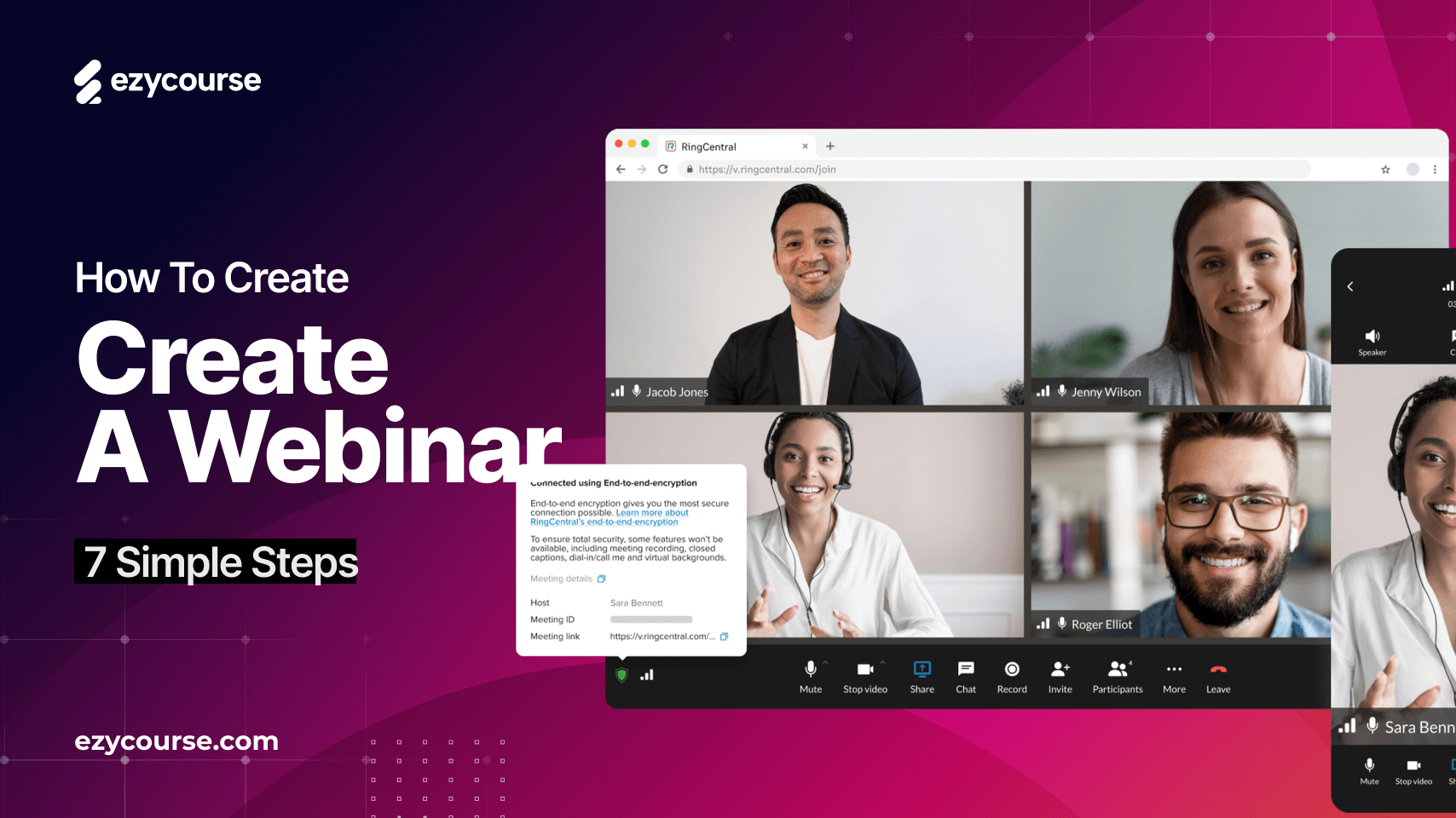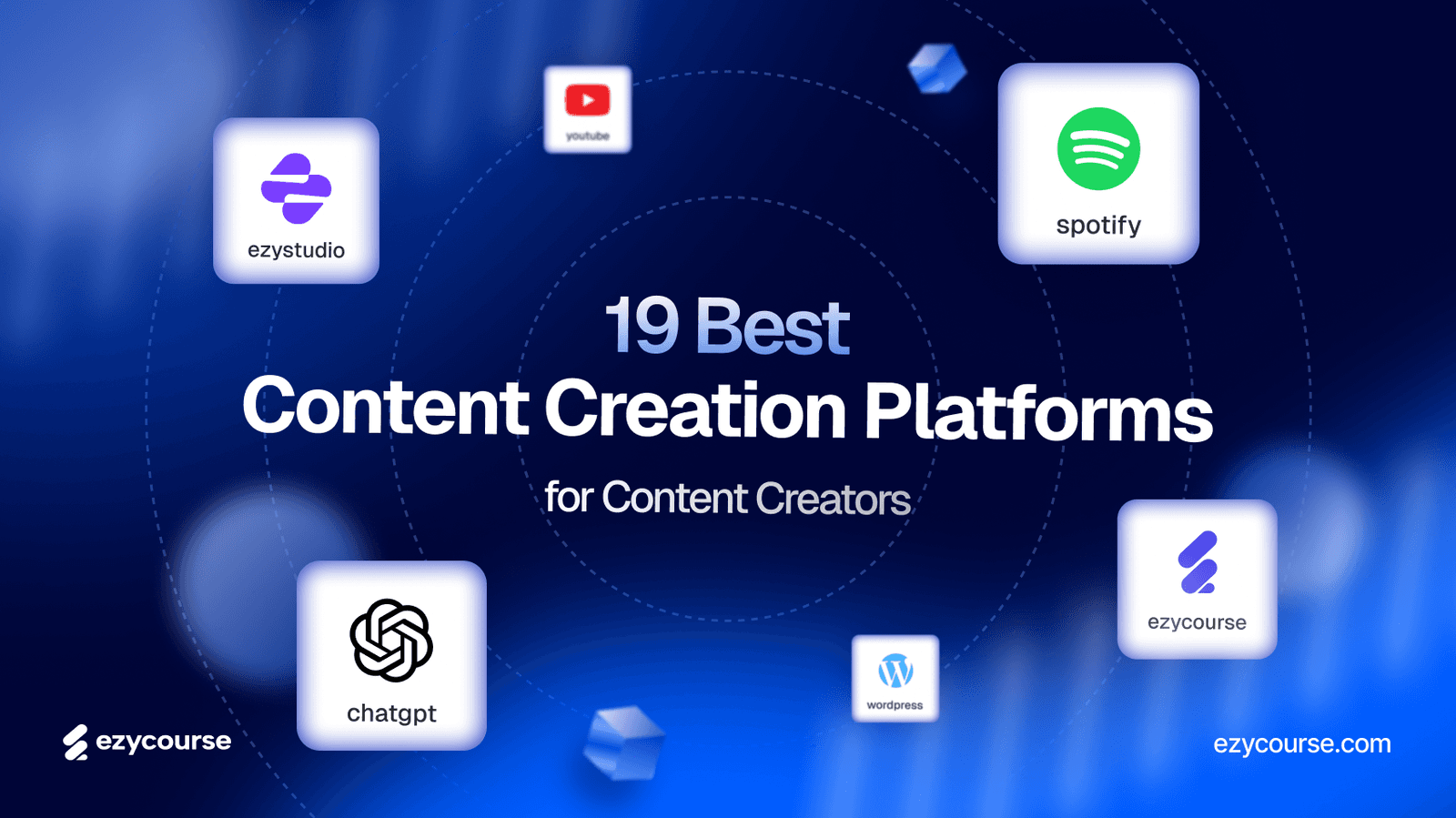Want to generate quality leads? Webinars can be your best bet—even 73% of B2B marketers say they bring in the best leads. That’s a big deal when your main focus is growth!
But let’s be honest here! Creating a webinar seems like a massive task, right? We understand it can be challenging with the planning, tech, or promotion.
But the good news is, that you can create a webinar easily with just a few steps. All you need to do is choose a topic and plan your content. Then select a suitable platform. You’ll need to promote strategically and do a dry run. That’s all, you’ll be ready to host your webinar!
For your ease of understanding, we have broken it down into 7 easy, actionable steps on how to create a webinar without any stress. Let’s dive in.
How Do Webinars Work?
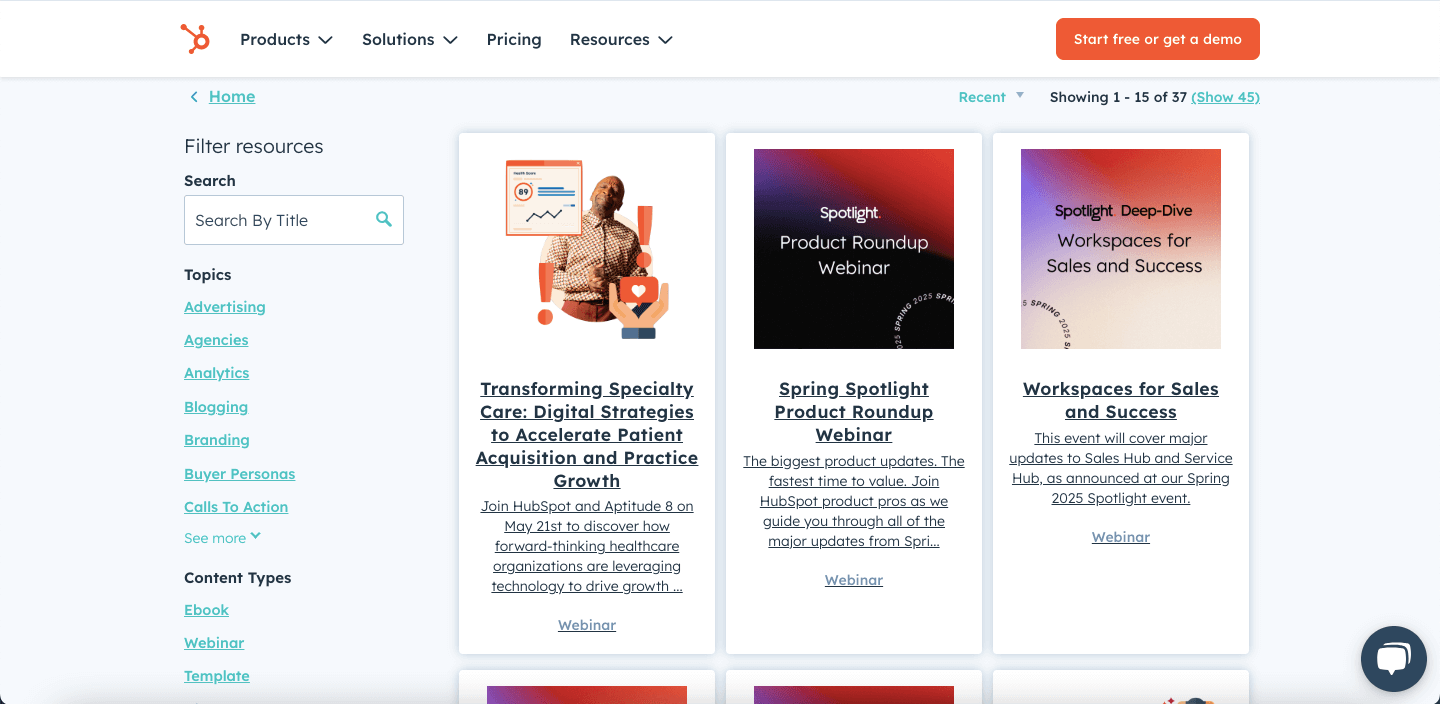
Webinars have become a crucial part of modern marketing strategy. They can offer an effective and cost-effective way to engage your audience and deliver targeted messages globally.
It provides an effective platform to connect with the audience, whether for educational purposes or for products.
Webinars are virtual events where the audience can attend live or watch later as a recording.
With the use of webinar tools, the host can present the content live or at their convenience through pre-recorded webinars.
There are mainly three types of webinar styles.
I) Solo webinar
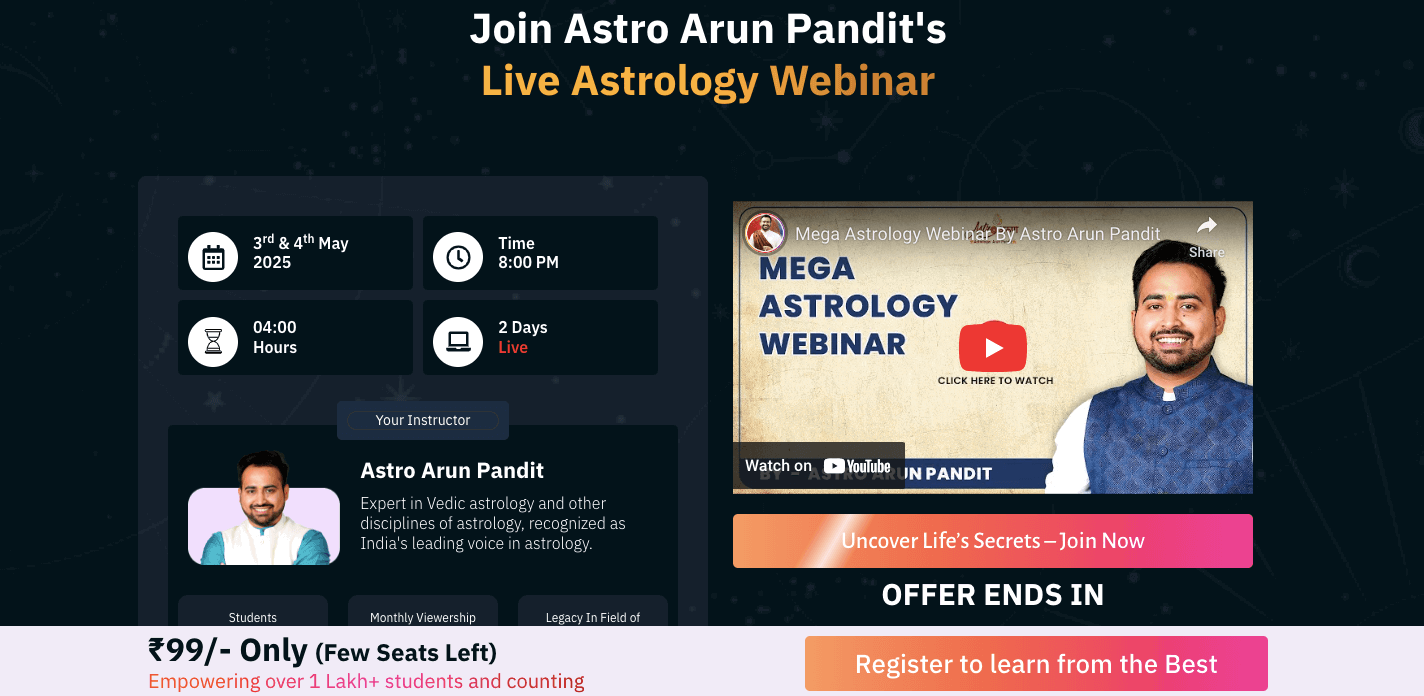
This is the most common format. Here, an expert delivers a presentation. Here, he/she often presents a webinar using a slide deck.
II) Interview panel
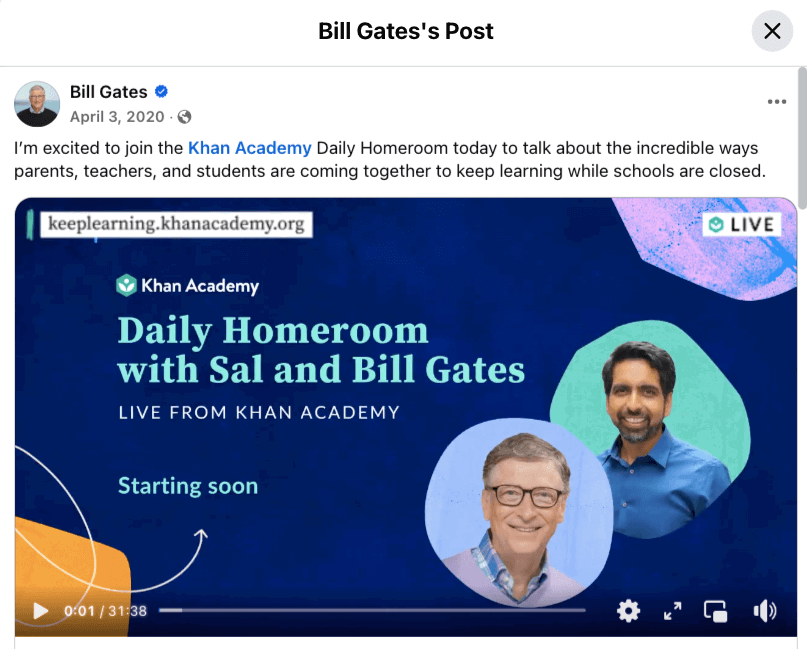
In this type of webinar, a host interviews an expert on a specific topic. It is very similar to a podcast.
III) Group discussion
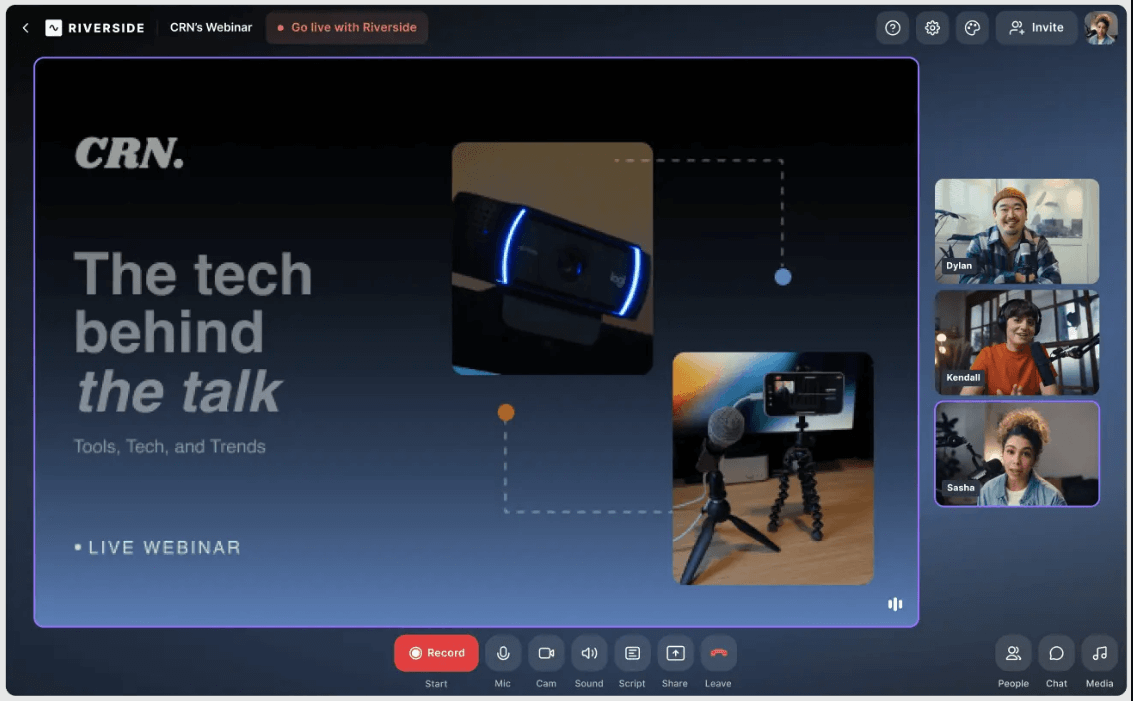
Group discussion is less common during webinars. However, they can be highly effective. You can offer insights from many experts in just one session.
Typically, modern webinars run between 30 minutes to 60 minutes. They are offered free of charge.
How To Create A Webinar In Just 7 Easy Steps
Research suggests that 85% of businesses consider webinars as essential for lead generation and engagement of the audience. In fact, 91% of B2B professionals prefer webinars as their top learning format.
How do you create a webinar and be a part of this hype? Let’s now learn about it.
Step 1: Choose A Topic & Format For The Webinar
First, you need to identify a topic that is relevant to your audience. Moreover, it should align with your goals.
You should focus on a topic that your audience cares about and is also really interesting to them.
Here are a couple of questions to ask yourself to get your wheels turning.
What are their pain points?
What pain points can you solve?
What are their interests?
What do they already know?
What questions does your target audience keep asking?
You have to create your content addressing their issues and offering them practical solutions.
When your webinar topic matches your audience's interest, they are likely to pay more attention and stay engaged.
Feeling confused about how to choose? Below are some ideas that can help you out.
i) Survey local customers
Loyal customers are a great way to help you choose a topic. You can conduct surveys to know their challenges and interests.
Their honest feedback can help you identify high-impact webinar topics that truly resonate.
ii) Poll your audience
If you have an existing audience or email list, consider polling your audience to gather ideas for potential topics.
Allow them to vote or suggest ideas. Through this approach, you can kill two birds with one stone—choose relevant content and also build engagement even before the event!
iii) Engage with industry communities
Online communities, professional groups, and forums are excellent sources to find inspiration for topics.
You should participate in discussions. It will help you to identify repeating questions and trending concerns.
iv) Monitor industry trends
This is also a crucial one when choosing a topic. You should keep a close eye on the latest developments in your industry.
Emerging trends and hot topics are more likely to attract attention and show thought leadership. It can place your brand as forward-thinking.
Find A Suitable Format
Next is choosing a suitable format. Before you move ahead to your slide creation, it is essential to select the right format for your chosen topic. Consider-
Are you going to prefer a single presenter who will deliver the presentation?
Will it be an interview, Q&A-style webinar with two speakers?
Will it be a group panel discussion with multiple experts?
You should choose the format according to the complexity of the topic and the availability of knowledgeable speakers.
Step 2: Put Your Team Together And Decide Who Will Present It
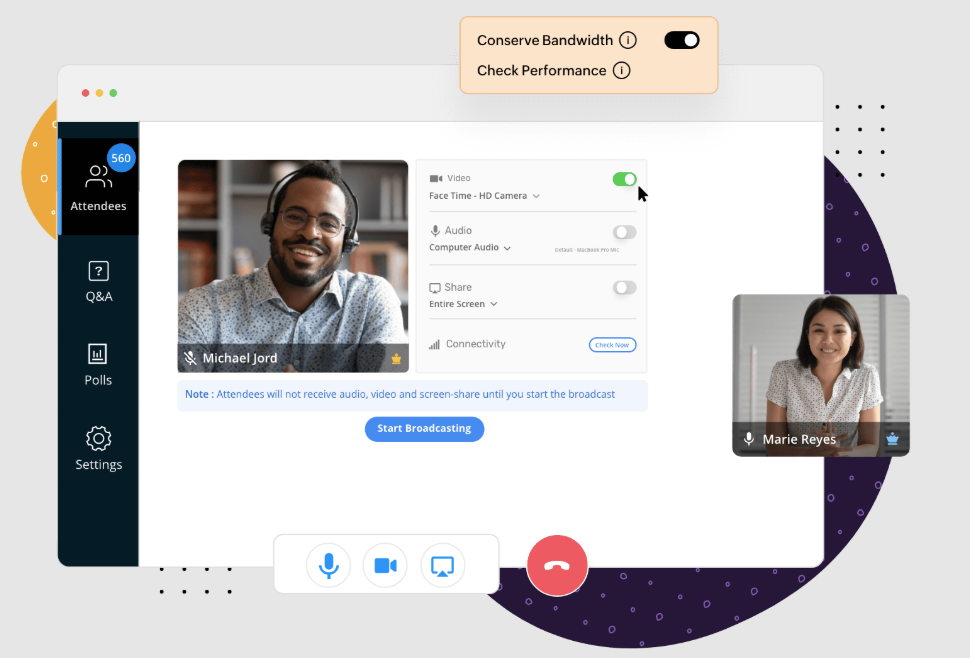
In simple words, webinars are a team effort. So, obviously, without the right support, the chances of your success will markedly reduce.
Take a look below at the roles needed to build a successful webinar team.
Webinar Host
This is likely the presenter who will present the webinar. As the host, they will be responsible for guiding the event.
The presenter should know the topic well and feel confident speaking in front of the audience.
They will guide the session, and highlight the important points. Moreover, they will keep the audience connected with the speakers.
If you need a presenter, pick someone who has real-life experience with the topic and knows how to lead the discussion.
Moderator
If you are expecting a larger audience for your webinar, like 100+, it is highly recommended to have a dedicated moderator backstage.
He or she will manage the chats, polls, and other interactive elements backstage.
In this regard, Pauline Mura, Partnership Marketing Manager, said, "It's handy to have the moderator chat feature, especially when you have a lot of speakers. That way you can ping them and ask 'Can we speed it up?' or whatever”
Speakers
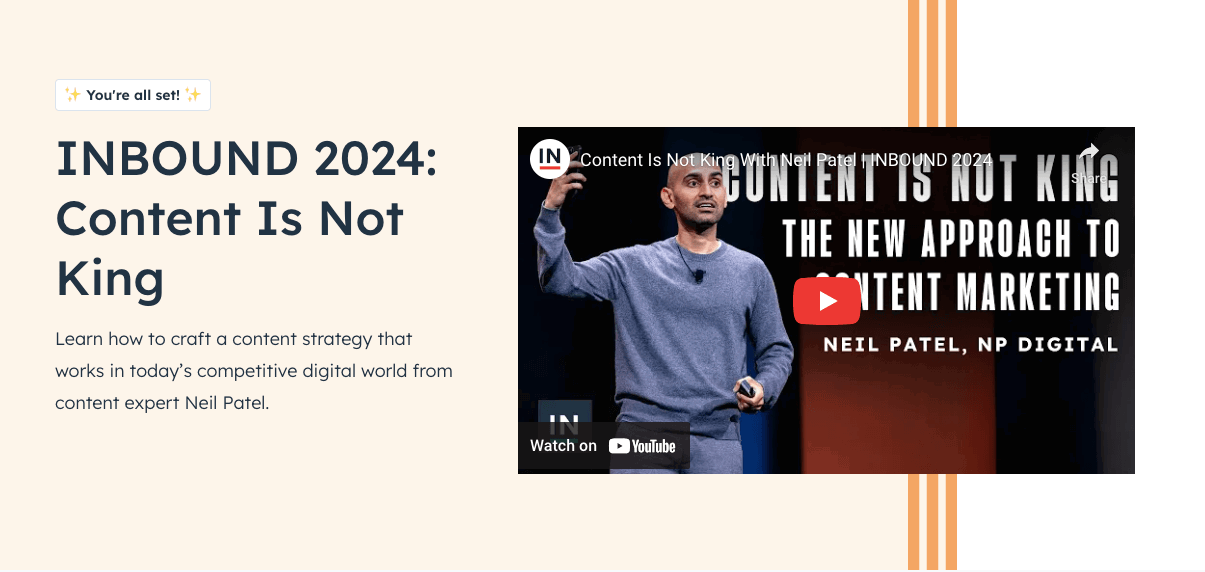
Your speakers are the subject matter experts who will provide valuable insights. You should choose a speaker who knows the topic well. Moreover, they have to be able to explain it clearly and keep the audience interested.
If possible, you can brief them about the session in advance. You can discuss with them the time they may have and the points you want them to cover.
Backup Host
Technical issues, and last-minute emergencies can happen. For this reason, it is smart to have a backup host.
If the main host fails to attend the webinar or runs into issues, the backup host can quickly step in. He/she will keep everything on track without disrupting the experience of the audience.
Not sure how to create a webinar in 2025? Meet EzyCourse, an all-in-one online platform to create, host, and promote a winning webinar and virtual events. Start your free trial now and host your first live webinar!
Step 3: Structure Your Webinar And Create Content

Your audience is investing their valuable time and attention in your webinar. So, of course, they will expect meaningful, high-quality content in return.
When you meet these expectations through your webinar, it enhances their experience. No need to say about enhanced engagement, trust, and future attendance!
I) Plan the Structure
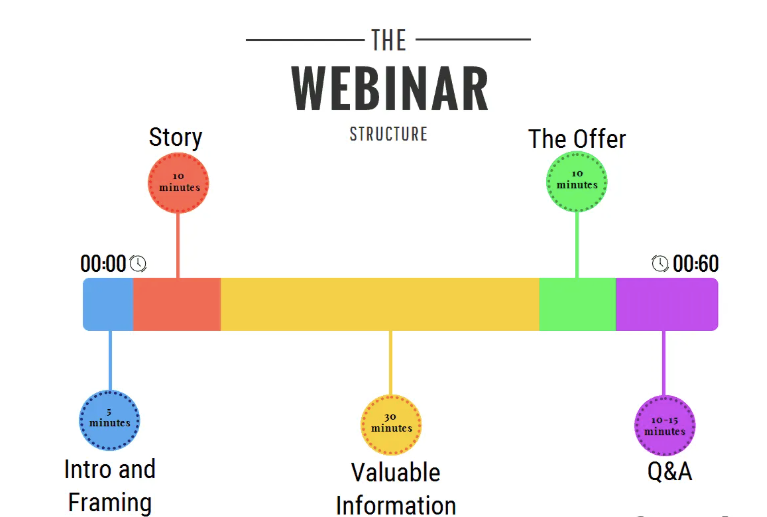
First, you need to outline the flow of your webinar. A clear structure can keep the presenter and the audience on track. You will need to structure the outline according to your topic and audience requirements.
However, here is an idea for a simple format.
Welcome and Introduction- 5 minutes
Main Presentation- 20–30 minutes
Interactive Elements- 10 minutes
Closing and CTA- 5 minutes
II) Prepare a Script
You know it is wise to have a script or talking notes about the webinar. That’s true even if you're comfortable with presenting.
That’s because it ensures you or your presenter stays focused and delivers the message efficiently.
Well, you don’t need to write it down word-for-word, AI is here! Take help from GPTs to make your script.
However, bullet points often work best instead of making full scripts! Just keep in mind below things-
Keep your message clear and on track.
Avoid rambling or going off-topic.
Ensure timing stays within the planned agenda.
III) Create Audience-Focused Content
So, how do you create a webinar presentation for free? Now, create a well-structured presentation with engaging and interactive elements. You should include slides, polls, and videos.
Moreover, you should keep the content easy and concise. More importantly, it must have to be audience-focused.
When writing the content for your slides, keep these three things in mind.
If you are going to have a global audience, some members may not be fluent in English. So, use an effective and simple tone and language.
Some of your audience may not be familiar with your presented content. So, make sure to give context for them. However, you should keep the explanation concise.
You should avoid using company-specific terms. It can be easy to understand for you and your team. However, it can confuse your audience.
For this reason, you should use the terms that are easy to understand by your attendees.
IV) Make It Interactive and Visually Appealing
To make the content interactive, consider the following ideas.
Use visual aids: You should enhance your presentation with different visuals, such as slides, images, and short videos. It will help to maintain the interest of the audience and support different learning styles.
However, you should always keep in mind that you have to add elements to support your messages. They should not distract your audience!
Consider storytelling: You can try to infuse compelling narratives into your presentation. When you add this strategy to your webinar, it humanizes your messages. Moreover, you promote an emotional connection with your audience.
In this regard, you can use real-world examples, case studies, or personal experiences. It will make your content more relatable.
Step 4: Set Up Your Webinar Tools
Now you need to set up the right tools that will support your webinar from start to finish. It includes choosing the right platform, an easy registration process, and a well-equipped studio.
i) Choose Your Webinar Platform
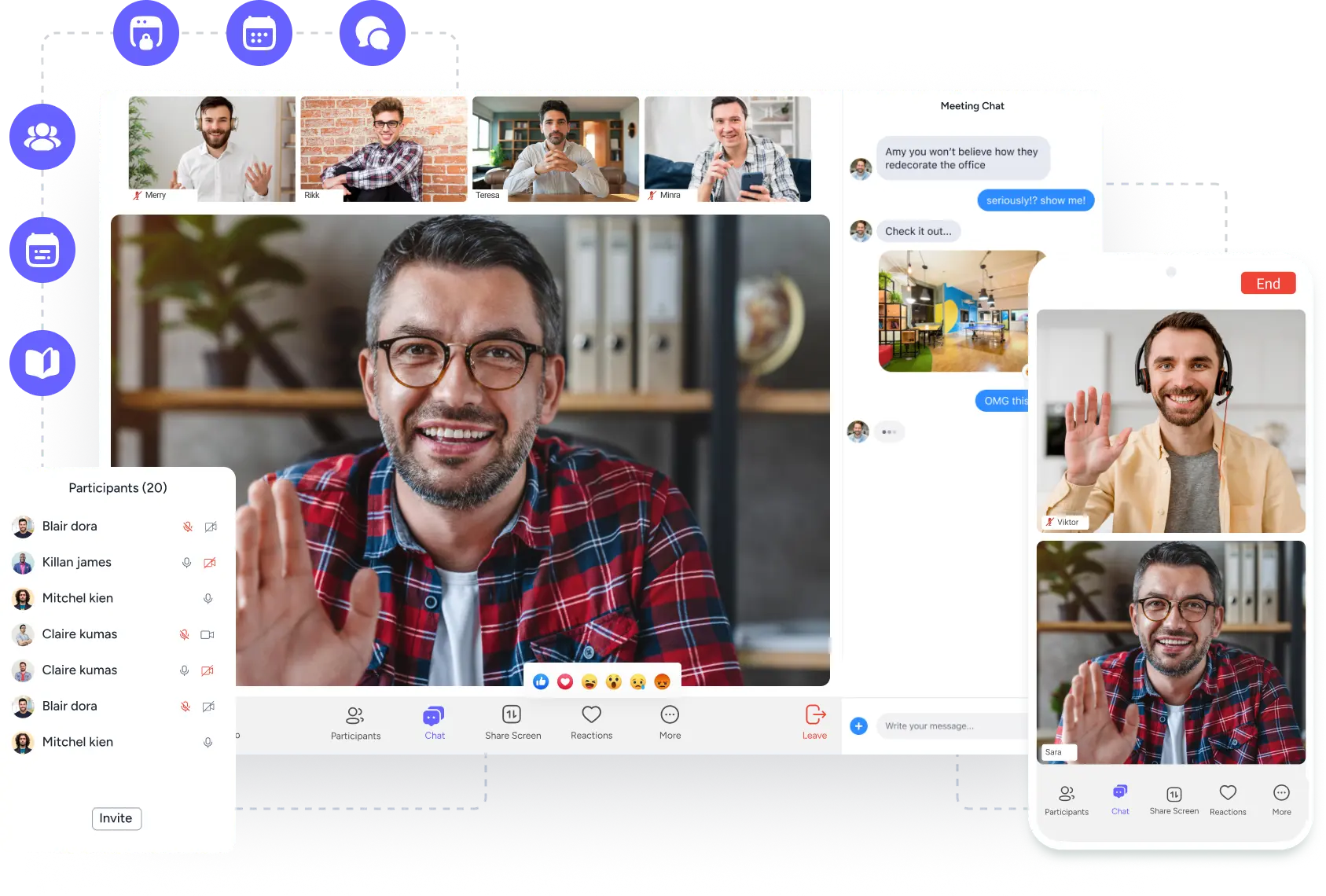
If you are wondering how to create a webinar on your own, a platform can be your survivor. When the matter is about ensuring the success of your webinar, choosing the best webinar platform plays a very crucial role. You have to choose a webinar platform that is easy to use for you and your audience.
As the organizer, you will need a platform that simplifies the tasks. For instance, inviting speakers and managing the event.
As for your attendees, a user-friendly experience is essential. You know, any problems in using the platform can reduce attendance. Ultimately, it can impact your conversion potential.
Other must-have features in the webinar software are
Video and audio conferencing: High-quality video and audio conferencing technology is very important to ensure a successful webinar
The platform you will choose should support clear communication with minimal tech issues. It will allow the presenters and participants to interact easily.
Session recording: It is possible that some audience members will not attend the webinar live. In such cases, it is wise to have a recording of the live session. You can offer on-demand replays and share them with anyone who missed out on it.
Screen sharing: When you are presenting online, some topics can be hard to explain just with words. Screen sharing lets you show your screen to everyone. It makes it easier to share data or live demos. Thus, it helps to offer a more visual and engaging experience for your audience. Moreover, this feature is also helpful for training your team, and showing step-by-step processes.
Session materials: The ability to upload and share files like PDFs, whitepapers, and slide decks during a webinar adds extra value.
It keeps your audience engaged, offering useful resources. Moreover, these materials can also serve as useful takeaways after the session ends.
Surveys and polls: The webinar platform should have interactive features like polls, Q&As, and surveys. It is to keep your audience engaged and offer real-time insights. They also offer a voice to the audience and make the webinar session compelling.
Session analytics: The post-analytics feature of the webinar platform lets you measure success and find out areas for improvement.
You should look for platforms that track attendance rates, engagement levels, drop-off points, and poll responses.
These features play a great role in refining future sessions and maximizing ROI.
Related Read: Top 10 Best Streaming Platforms in 2025
ii) Create The Registration Page From That Platform
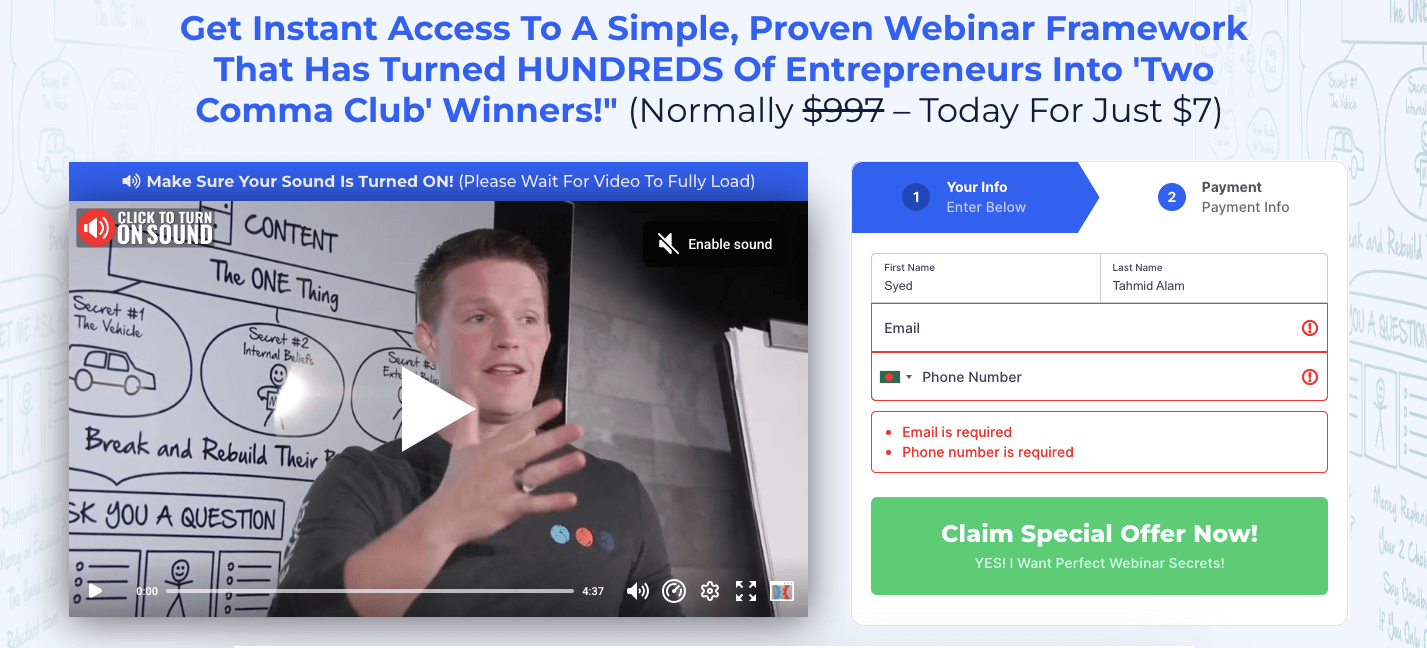
The first rule for webinar registration is that the harder to sign up, the fewer people will register. So, make the registration process as quick and easy as possible.
Most webinars use standard landing pages where people can see the details about the webinar and fill out a form. The registrant receives a confirmation email after completing the form.
This works great for the lead-gen webinars. That’s because the registrants will need to provide their personal details. Like an email address, job titles, or company name to sign up.
However, what if you are targeting your existing customers? You already have their info. So, asking them to fill out the same details can again waste their time and be annoying for them. For such cases, you can use 1-click registration.
Here is how it works.
You send an existing email.
The email has a clear CTA button and a short message that says, “Click here to register.”
When they "click," they’re instantly registered and sent a confirmation email.
Here, there will be no form, no extra pages, or no extra steps. Just one click!
After the registrants register for the webinar, be sure to send them a confirmation email. This email should include the key details of your webinar. For instance, the webinar topic, date, and time, and the link to join the session.
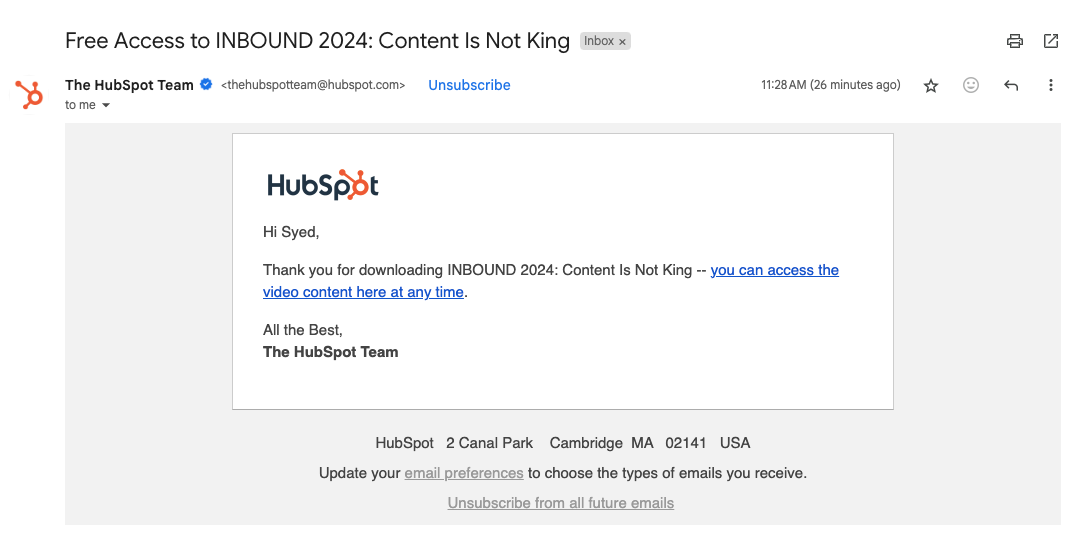
Generally, it is highly recommended to add an “Add to Calendar” option. This simple step makes it easy for the registrants to save the event to their personal calendars. Ultimately, it helps to improve the attendance rates!

iii) Create Your Webinar Studio

Frankly speaking, your webinar studio does not necessarily mean it has to be fancy. It needs to be quiet and distraction-free.
Use a good webcam and quality microphone to make your presentation look professional.
Natural lights work best. But if it is not possible, you can use a ring light or softbox light to light up your face evenly.
Another important thing, check your internet connection. A wired connection may be more reliable than a wifi connection.
Before you go live, test your setup: audio, video, background, and screen-sharing—all of it. You want to feel confident and ready when the session begins.
Step 5: Do A Dry Run
One crucial thing in planning a webinar that is often overlooked is rehearsal. There is no denying that organizing your content and considering the needs of the audience are crucial steps.
But the delivery — encompassing your words, tone, and presentation style—can make or break the success of your webinar.
"The biggest challenge for keeping an audience engaged is keeping track of time and making sure that the speakers don't go over. Sometimes they get off track. So, it's about making that choice: do I refocus the conversation, or do I cut some of these questions?’’
-Pauline Mura, Partnership Marketing Manager
As Pauline Mura rightly points out, a dry run helps you master timing, stay on track, and deliver an engaging experience for your audience.
Timing
Practice your timing to ensure the webinars run smoothly and adhere to the schedule's duration.
You can focus on things like taking pauses for emphasis and smooth transitions between the gaps.
It will help you to maintain the flow without rushing through the critical points and ending too abruptly.
You can enhance the overall experience of the audience with proper timing and ensure the key content of the webinar is delivered effectively.
Body language
Your body language matters too. It plays a significant role in engaging your audience. When you do a dry run, it allows you to refine your gestures, facial expressions, and overall your presence.
The benefit will be that it will enhance your confidence and ensure that you come across as approachable during the webinar.
Flow
How your content will flow from one topic to another is a very important thing. A well-rehearsed presentation will have transitions between the sections.
It makes it smooth and natural. Moreover, it will prevent any awkward transitions and confusion for your audience.
Step 6: Promote Your Webinar
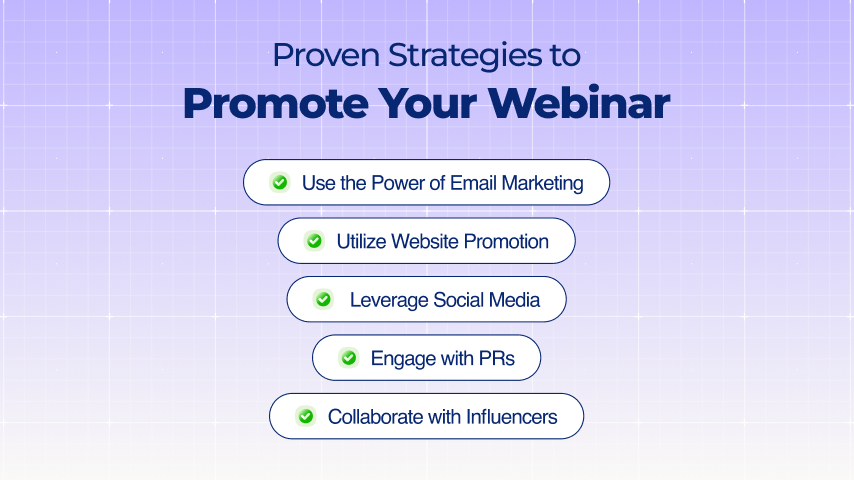
Promotion is everything! To make your webinar successful and to ensure your webinar is well attended and effectively captures the interest of your attendees, you need to use strategic marketing and promotion tactics.
Whatever your webinar topic is, whether you are planning to share your expertise, business topic, or educate your audience, success more likely depends on your ability to reach your target audience.
Here are a few marketing and promotion tactics that you can use.
I) Use the Power of Email Marketing
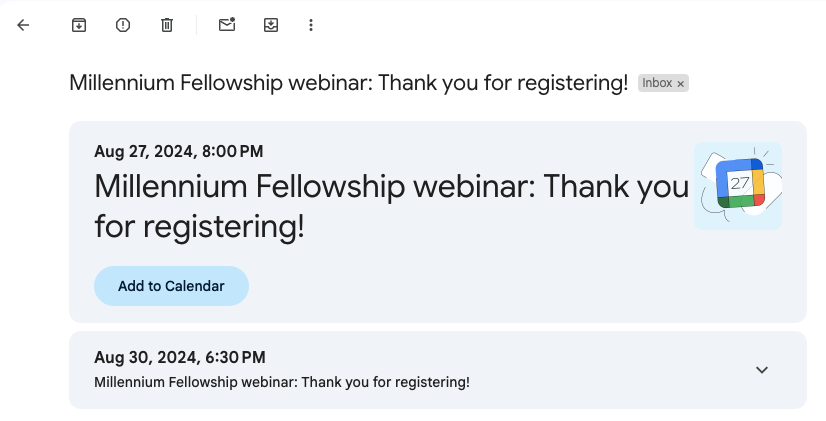
Emails still remain one of the most reliable and effective channels for webinar promotion.
For this reason, you can design visually appealing and well-structured email campaigns. It will help you to announce your upcoming event to your subscriber base.
Moreover, create compelling subject lines and clearly communicate the benefits of attending to your audience.
You can also include a prominent call-to-action that directs recipients to the registration page.
It will be wise to include a reminder sequence to ensure maximum attendance and engagement on the day of the webinar. Research shows that emails with personalized subject lines enhance the open rates by 26%.
II) Utilize Website Promotion
Your website can also effectively help you to reach and convert visitors who are already interested in your offerings.
Take advantage of this by placing eye-catching banners, pop-ups, and homepage announcements that promote your webinar.
You should consider using high-quality visuals and persuasive messaging to capture attention and guide users to register.
When you use on-site promotions, you create consistent visibility for the webinar across your digital presence. It enhance both awareness and conversions.
III) Leverage Social Media
Nowadays, it is a great way to spread your words about the webinar to a large audience.
Strategically use these channels to publish engaging and informative content that highlights the value of your upcoming session.
You can develop teaser posts, share relevant insights, and offer a sneak peek into the key takeaway your audience can expect from your webinar.
Encourage your followers to share your content. Thus, you can expand your reach through their networks and communities.
IV) Engage with PRs
Partnering with PR or Public relations experts or media organizations can markedly enhance the visibility of your webinar.
Some examples can include strategic press releases, media interviews, and editorial features. Through these, you can create a buzz and reach audiences beyond your existing network.
That is especially true when your webinar covers timely or high-demand topics. A media can drive qualified traffic to your registration page.
V) Collaborate with Influencers
You know, B2B influencers hold considerable sway within their professional communities.
It makes them a powerful companion in webinar promotion. Their already-established credibility and engaged audiences provide a unique opportunity to expand your reach and build trust with potential attendees.
When you organize your webinar, consider involving influencers in both the planning and promotion phases.
Their expertise in attracting the audience can enhance the quality of your event, while their endorsement can boost attendance and engagement.
Below are some proven strategies that you may want to try.
Sponsored LinkedIn Posts: You can invest in high-impact LinkedIn content with the influencer discussing your webinar topic. This approach effectively taps into their professional network.
Webinar Co-hosting: You can also invite the influencers to co-host or speak at your webinar. Their participation will enhance the credibility of your webinar. Cherry on the cake? It will draw in a wider, more engaged audience!
Influencer Webinar Series: If you can, launch your webinar series featuring various influencers across your niche. This broadens your reach and keeps your audience coming back for new insights.
Customized Promotions: You can also work with influencers to create personalized promotional strategies that align with their voice and appeal to their followers.
Influencer Shout-outs: Encourage the influencers to mention your webinar on platforms like LinkedIn or X (formerly Twitter) and so on. In these platforms, B2B engagement is strong, and professional discussions thrive.
Step 7: Follow-up And Analyse After The Webinar
The webinar does not end when the event is over. What you do after also matters as much. That’s especially true when you want to turn attendees into leads or loyal customers.
Follow-Up with Attendees
Right after the webinar, send follow-up emails to your attendees. It can include a thank you message for joining and a link to the webinar recording.
Moreover, you should provide any promised resources like slides, PDFs, and bonus content.
It is also better to send emails to people who registered for your webinar but couldn’t attend. If you want, you can also send the recording and a short recap to them.
Review the Performance
Next, take time to look at the numbers. Check what has actually worked out and what needs to be improved next time. especially focus on
Registration vs. attendance rate
Engagement
Drop-off points
Conversion rate
What questions were asked during the Q&A
Gather Feedback
Last but not least, ask for feedback from your audience. Ask them what they like about your webinar and what could be better. Real feedback from the audience helps you grow and create better webinars in the future.
Successful Webinar Examples
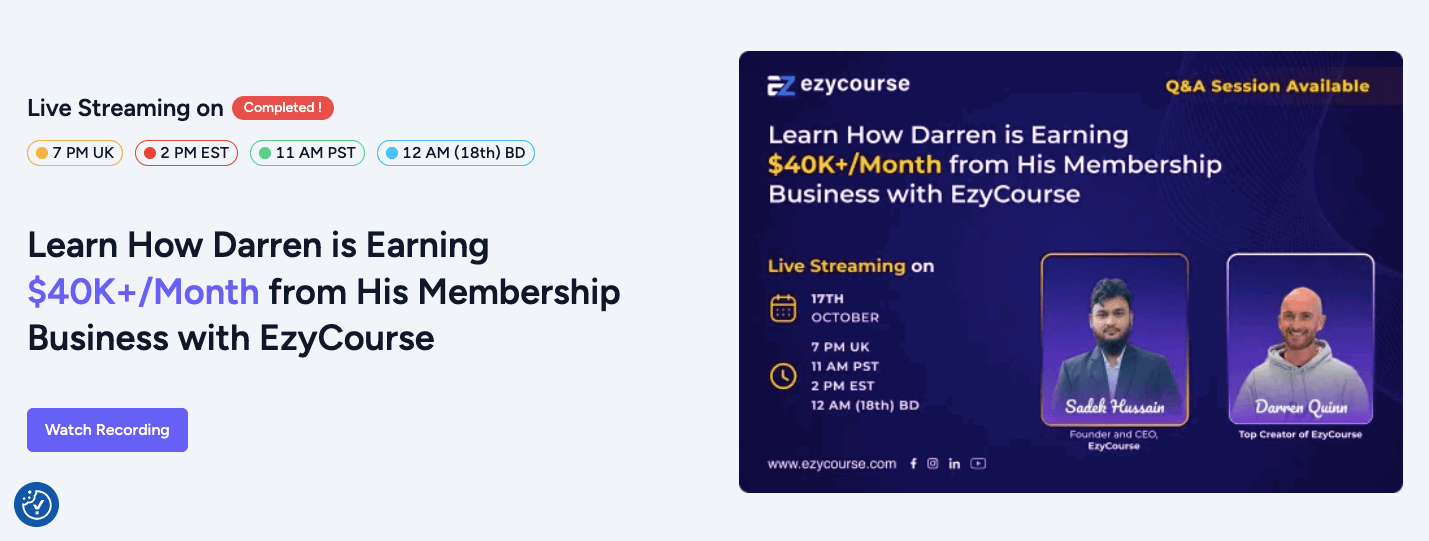
Now that you know how you create and host a webinar, let’s check out some webinar presentation examples. These examples will help you to understand how to create webinars, no matter what your niche or industry is.
EzyCourse is an all-in-one platform for creators and educators. The platform uses webinars as a strategic tool to educate, build trust, and drive platform adoption to both educate users and promote their platform features.
In one webinar, “Learn How Darren is Earning $40K+/Month from His Membership Business,” they invited a real user to share his journey.
This approach not only builds credibility but also creates authentic content that resonates with aspiring course creators.
With this strategy, the audience learns something useful and sees what’s possible using the platform—without a hard sell.
In another webinar, “Unveiling EzyCourse Builder 2.0,” the team delivered a live product demo. It’s a smart strategy for launching new features, answering user questions in real time, and collecting feedback. The live Q&A also kept the session interactive and helped increase engagement.
These examples can be great models for anyone looking to create value-first webinars that convert without being overly salesy.
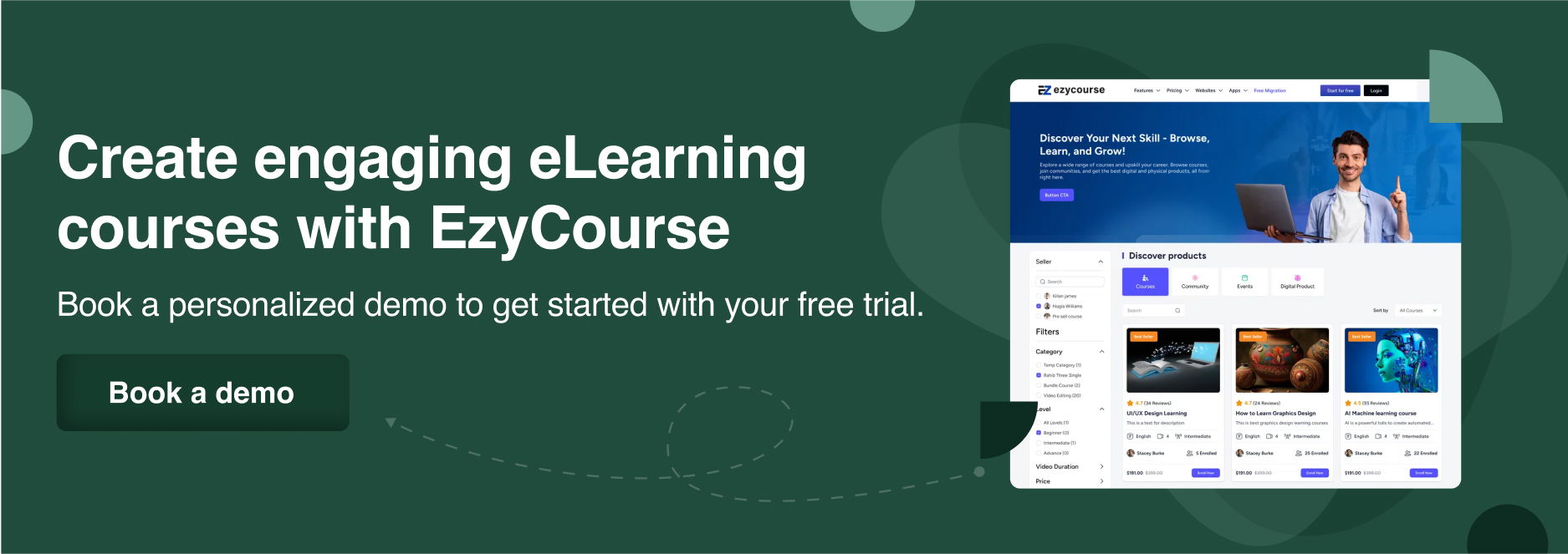
5 Reasons Why Webinars Are Great
Webinars have become one of the most effective tools in digital marketing. Want to build relationships with leads? Aim to grow your audience or promote your brand? Webinars can help you with all!
Just a few examples are below.
Webinars Offer a High Conversion Rate.
Webinars are commonly used as a lead-generation tool. Recently, webinars have outperformed other marketing options in conversion.
Research shows that webinars turn 20% to 40% of webinar attendees into leads for B2C or Business to Consumers.
That means your customers end up purchasing after attending a webinar. The reason? Webinars allow deeper engagement and build trust among your audience.
Webinars Strengthen Your Industry Relationship
Webinars offer a great way to connect with your audience and create industry relationships.
You can build two-way communication with it. It can be through Q&A sessions, polls, and chats.
This kind of interaction helps create lasting relationships with customers and partners in your field.
Webinars Establish You as an Authority
When you share your knowledge through webinars, it instantly positions you as an expert.
You are not just telling people what you do, you’re showing them. It is one of the most direct and efficient ways to earn credibility and stand out from your competition.
Webinars Promote Your Personal Brand.
Regularly hosting webinars helps to enhance the visibility of your brand. It allows you to show your knowledge. You can engage with a broader audience and establish an efficient online presence.
Webinars Help Grow Your Email List
Need to grow your email list? Webinars can be a good opportunity for that. Statistics say, about 57% of webinar registrations come from email campaigns, and 76% of people sign up via email.
How Do You Create A Webinar & Conduct It Effectively
Webinars are a powerful way to connect with your audience, but only when they’re done right. In 2025, when attention spans are shorter than ever, you must be strategic and thoughtful to stand out.
Respect your viewers' time.
First off, it is crucial to be careful about your attendees’ time. Keep the webinar within the specified duration.
Ensure your content is focused, concise, and relevant. You know a concise and focused webinar helps maintain higher attendee engagement and satisfaction.
Moreover, never drag the session longer than necessary, and start and end the webinar on time.
Know your audience
It is likely to create a whole upside-down difference when you know who your audience is or who you are speaking with.
First, understand the needs and challenges of your audience. And then create your content addressing their needs, goals, and challenges.
Use the tone and language so that they can easily understand or can easily relate. If you are not sure what exactly they want, you can send a short survey before the webinar. It can effectively guide you in your content planning and creation.
Offer quality content
Coming to the next, you should focus on providing high-quality content with clear objectives.
Your audience is investing time. So, of course, make every minute count. Offer valuable ideas and practical and actionable tips.
Always try to back your content with examples. Your webinar will be more successful when you communicate with your audience directly and concisely in your webinar sessions.
You know the more helpful your content will be, the more likely your audience will come back for future sessions.
Plan and promote
A successful webinar largely depends on proper planning and promotion. Select an optimal time to conduct your webinar based on the preference of your audience.
Then, promote it through your email campaigns, social media, and website. You can also use reminders or calendars to invite.
It can enhance attendance. Better to start building interest at least a week in advance.
Encourage attendee engagement
Keep your audience engaged with interactive content and thought-provoking questions.
You can consider using polls, live Q&A sessions, chat features, and interactive elements to keep attendees involved.
If possible, try to call your audience by name. Ask questions and let the audience share their views.
The gist is that the more interesting and engaging your audience feels, the more they’ll remember your webinar and your message.
How to Create a Webinar or Virtual Event With EzyCourse
Want to create a webinar or virtual event without any hassle? EzyCourse makes it incredibly easy! Its user-friendly interface and features offer effortless setup, management, and promotion of your webinars or virtual events.
You can create different types of virtual events with Ezycourse. So, if you want to create a webinar very easily with EzyCourse, just follow up straightforward steps below.
Step 1: Go to Products & Services-> Events -> click on the Create Event button to create a new custom virtual event on Ezycourse.
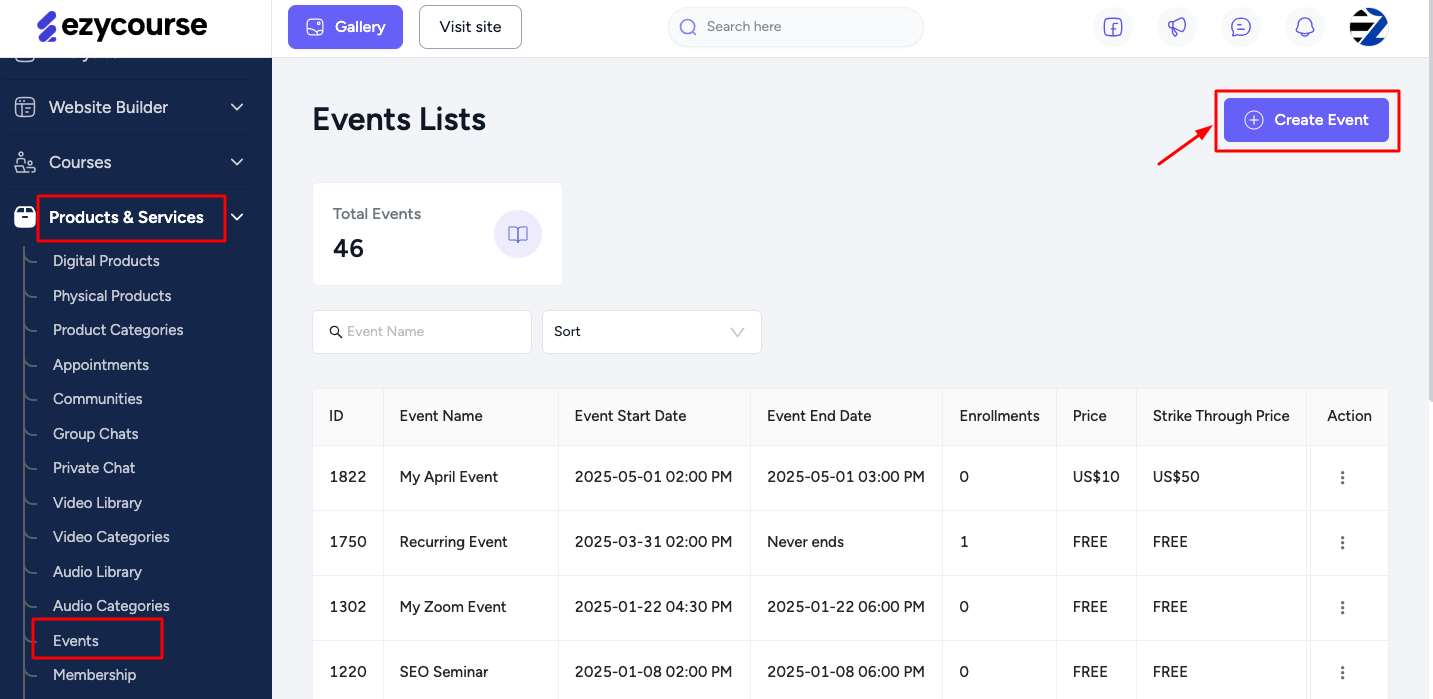
Step 2: Fill in the options present there. When all is done, click the Create button. It will create a new event.
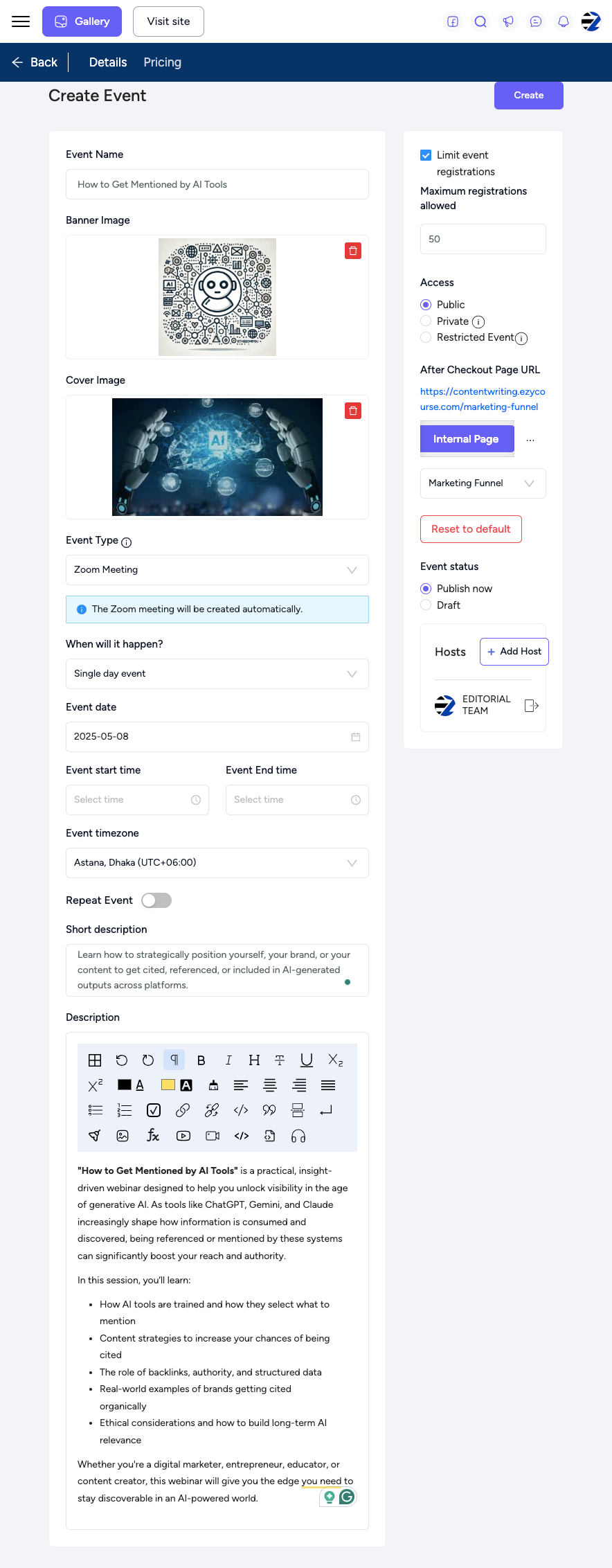
People who have registered for the virtual event can get all the details, along with the event link, on the dashboard. And the event page will be shown like this:
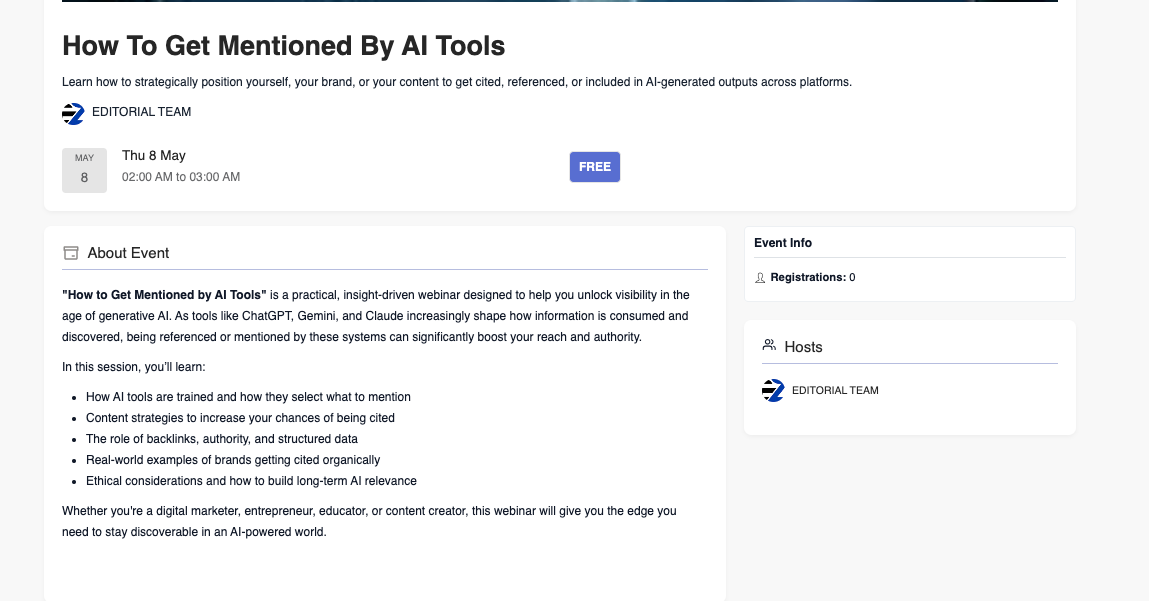

FAQs
Have some more queries? Let’s try to address some of your concerns through the queries that people mostly ask about.
What is the difference between a meeting and a webinar?
A meeting is a collaborative gathering where participants actively engage, discuss, and work together. On the other hand, a webinar is a one-way broadcast. Here, a presenter delivers information to a large audience, and interaction is generally limited.
Does a webinar have to be live?
Well, not necessarily. A webinar doesn’t always have to be live. It can be either live, simulated, or on demand. Live ones allow real-time interaction, whereas on-demand ones allow flexible viewing time. As for simulative webinars, pre-recorded videos are shown live.
What are some common use cases for webinars?
Webinars are used for a number of use cases, like product demos, training sessions, thought leadership, lead generation, and so on. They help businesses engage audiences, share expertise, and build trust while reaching people from anywhere.
How can I measure the success of my webinar?
Through the key performance indicators or KPIs, you can measure the success rate of your webinar. KPIs can be participant engagement levels, attendance rates, and post-event surveys. You can also track conversion rates to see the post-webinar actions.
How do I handle technical issues during a webinar?
For such cases, have a backup plan ready. You can assign a tech support team to help you fix the technical issues. Give the attendees clear instructions on potential solutions and assure them of a quick resolution. If needed, switch to a backup system or a pre-recorded version to keep things running smoothly.
How long should a webinar be?
Actually, that depends on your chosen topic, audience interaction, and size. However, the ideal webinar duration should be generally 45 minutes to 1 hour. This timeframe will allow you to comprehensively cover the chosen subject without overwhelming the audience.
How do I create a poll in a Zoom webinar?
To create a poll, you need a Zoom webinar license and polling enabled in your settings. Once your webinar is scheduled, you can add polls from the webinar management page. During the live session, click the "Polls" button on your toolbar to launch it.
How do I create a live webinar using PowerPoint?
To run a live webinar with PowerPoint, you have to use a platform like Zoom. Start your webinar, share your screen, and open your PowerPoint presentation. You can use Presenter View to access your notes and engage your audience with visuals, animations, or even embedded videos during the session.
How do I create a webinar on Zoom?
Start by scheduling a webinar from your Zoom dashboard. Add the title, description, date, and any panelists. You can enable features like registration, Q&A, or practice mode. Once scheduled, share the join link with your audience and start the session when you're ready.
How to Create a Webinar: Final Words
After all the comprehensive discussion on how to create a webinar, let’s have a quick recap! When you want to create a successful webinar, start by planning your content, structuring the session, and using strategic promotion tactics.
With the right and strategic approach, your webinar can be an impactful tool for connecting, educating, and growing your community. Create, promote smartly, and watch your audience grow!

